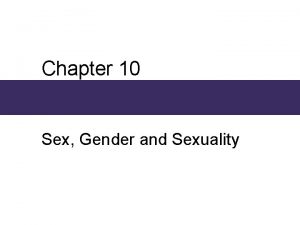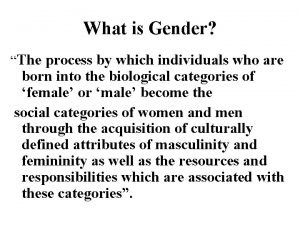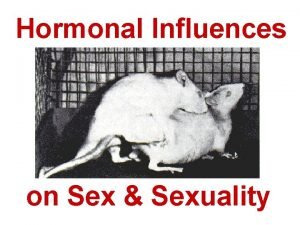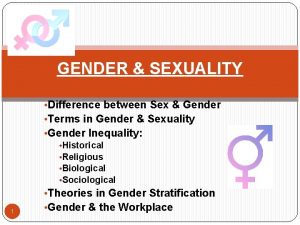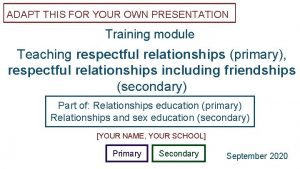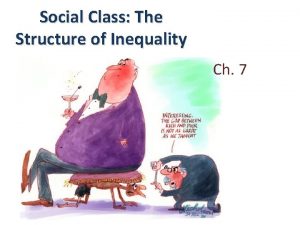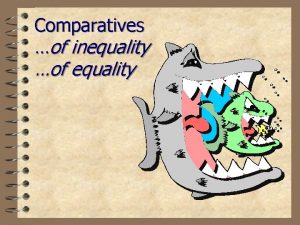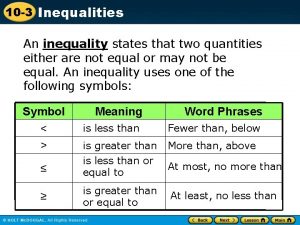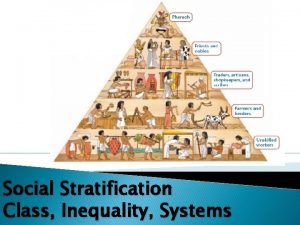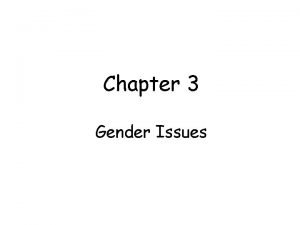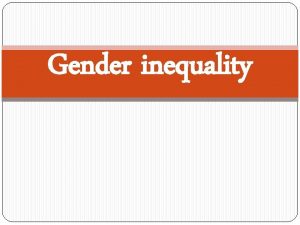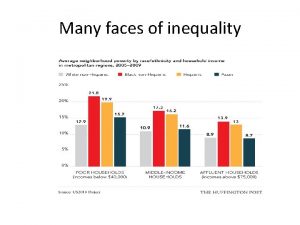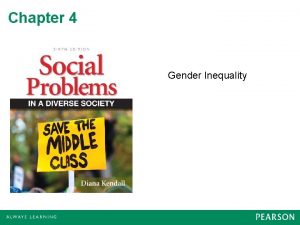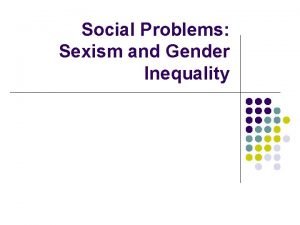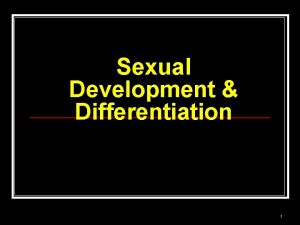Gender inequality Sex Gender and Sexual Orientation How



































































- Slides: 67


Gender inequality

Sex, Gender and Sexual Orientation How do we differentiate between sex and gender, define sexual orientation? Describe the socialization of gender and gender inequality Explain sexual attitudes and practices

Sex and Gender • Sex – biological • Gender – deeply held internal perception of his/her gender.

Gender • Gender – Expectations associated with occupying status of male or female – Gender varies greatly between different societies • Dressing in skirts • “The third gender” – Native Americans, India, Samoa

Gender Role • The term gender role refers to society’s concept of how men and women are expected to look and how they should behave. These roles are based on norms, or standards, created by society. This Photo by Unknown Author is licensed under CC BY

Social Construction of Gender • Gender is socially constructed and a result of sociocultural influences throughout an individual's development (Schneider, Gruman & Coutts, 2005). • “women hold up half the sky” China

Social Construction of Gender • Gender roles: expectations regarding proper behavior, attitudes, and activities of males and females – Most people do not display strictly “masculine” or “feminine” qualities all the time – Socially construct behavior so as to create or exaggerate male/female differences

Social Construction of Gender • Gender identity can be affected by, and is different from one society to another depending on the way the members of society evaluate the role of females and males.

Gender Roles in the United States • Gender-Role Socialization • Boys must be masculine • • • Active Aggressive Tough Daring Dominant • Girls must be feminine • • Soft Emotional Sweet Submissive

Gender Roles in the United States • Men’s Gender Roles • Attitudes toward parenting changing (stay at home dads), but little change in traditional male gender role • Do you want to date a male nurse? • Males who do not conform to socially constructed gender role face criticism • Boys who successfully adapt to cultural masculinity standards may grow up to be inexpressive (= tough)

What is gender inequality Gender inequality refers to unequal treatment or perceptions of individuals based on their gender. It arises from differences in socially constructed gender roles. https: //www. youtube. com/watch? v=d. SHJYy. RVi. IU

Gender Roles This Photo by Unknown Author is licensed under CC BY-NC-ND

Gender Roles This Photo by Unknown Author is licensed under CC BY-SA

Gender stereotypes • Gender stereotypes form the basis of sexism. Sexism refers to prejudiced beliefs that value one sex over another. • Around the world gender stereotypes limit options given to girls, Further, they will grow up believing they deserve to be treated differently from boys (UNICEF 2011; Thorne 1993).

Access to education

Gender Inequality • Stratification refers to a system in which groups (female) of people experience unequal access to basic, yet highly valuable, social resources. • Before 1809—Women could not execute a will • Before 1840—Women were not allowed to own or control property • Before 1920—Women were not permitted to vote • Before 1963—Employers could legally pay a woman less than a man for the same work

Land ownership • In many countries like North Sudan, Tanzania, and Lesotho, land ownership and control tends to go to the male head of the household

Examples • Lack of Mobility Although there have been numerous protests, women are still forbidden to drive in Saudi Arabia, and must rely on their fathers or husbands to get from place to place.

Egypt and Bahrain, husbands have the right to stop their wives from leaving the country while other countries require written permission from a husband to travel. Sources: Discovery, List Verse

Women: The Oppressed Majority • Many have difficulty seeing women as subordinate and oppressed

President University of Houston

Gender doesn’t matter to most – Pew Research Center (2014)


Women noticeably underrepresented in U. S. political structure Source: Center for American Women and Politics, Eagleton Institute of Politics, Rutgers University Percentages of Women in US Congress 1971 1973 1975 1977 1979 1981 1983 1985 1987 1989 1991 1993 1995 3% 4% 5% 5% 5% 6% 10. 1% 10. 3% 1997 1999 2001 2003 2005 2007 2009 2011 2012 2013 2014 2015 2016 11. 0% 12. 1% 13. 6% 15. 0% 16. 1% 16. 8% 18. 5% 18. 7% 19. 4%

Gender and Annual earning

U. S. falls to 28 th on global gender equality list • The drop is mostly due to U. S. wage similarity for similar jobs dropping and fewer women in high government positions • Norway, Finland, Sweden and Ireland finished out the top five list. Rwanda was sixth and Philippines, 7. • Source: WEF Gender gap report

Why the gap? The median weekly earnings for full-time female workers were about 80. 4 percent of men’s earnings, according to fourthquarter 2015 statistics by the U. S. Department of Labor. African-American women were paid 63 percent of what white men earned in 2014, while Hispanic women were paid only 54 percent, the American Association of University Women, or AAUW reported.

Why the gap? • In 2014, the wage gap was smallest in Washington, D. C. , where women were paid 90 percent of what men earned, and largest in Louisiana, where women earned 65 percent of what men were paid, according to the U. S. Census Bureau's American Community Survey.

Direct discrimination • Some women are paid less than men for doing the same job. This factor only explains a small part of the gender pay gap This Photo by Unknown Author is licensed under CC BY-NC-SA

The undervaluing of women's work • More frequently women earn less than men for doing jobs of equal value. One of the main causes is the way women's competences are valued compared to men's. This Photo by Unknown Author is licensed under CC BY-NC -SA

Perception about competence • Studies have found that men receive significantly higher customer satisfaction scores than equally well-performing women. Customers who viewed videos featuring a female and a male actor playing the role of an employee helping a customer were 19% more satisfied with the male employee’s • In a second study, they found that male doctors were rated as more approachable and competent than equally well performing female doctors

Segregation in the labor market • Women often work in sectors (for example in health, education, and public administration) where their work is lower valued and lower paid than those dominated by men. When we look at the health sector alone, 80% of those working in this sector are women. This Photo by Unknown Author is licensed under CC BY-SA

Where is this?

Traditions and stereotypes • Segregation is frequently linked to traditions and stereotypes. Whilst in some cases this may reflect personal choices, traditions and stereotypes may influence, for example, the choice of educational paths and, consequently, professional careers that girls and women make. • While around 60% of new university graduates are women, they are a minority in fields like mathematics, computing and engineering

Marriage and motherhood • professor Shelley Correll and colleagues (2007) of Stanford sent out more than 1, 200 fictitious résumés to employers in a large Northeastern city, and found that female applicants with children were significantly less likely to get hired and if hired would be paid a lower salary than male applicants with children. This despite the fact that the qualification, workplace performances and other relevant characteristics of the fictitious job applicants were held constant and only their parental status varied. • Men were not penalized for, and sometimes benefited from, being a parent. • In a subsequent studies, researchers review results from other studies and argue that the motherhood role exists in tension with the cultural understandings of the "ideal worker" role and this leads evaluators to expect mothers to be less competent and less committed to their job

Balancing work and private life • Family, care and domestic responsibilities are still not equally shared. The task of looking after dependent family members is largely borne by women. Far more women than men choose to take parental leave. This fact, together with the lack of facilities for childcare and elderly care, means that women are often forced to exit the labor market.

Gender in Media

Socially determined stereotypes • Gender inequality is reinforced by gender stereotypes: • Set of prejudicial biologically-based generalizations about men and women in terms of personality traits and behavior ðPersistence of polarized gender stereotypes is supported by research

Sexism • Gender stereotypes form the basis of sexism • Sexism is a prejudiced belief that values one sex over another. • Example – Preference for sons in some cultures

Me too • https: //www. youtube. com/watch? v=8 m. L 1 k 1 U 0 a. Y

Infanticide This Photo by Unknown Author is licensed under CC BY-NC-ND

Sex Ratio This Photo by Unknown Author is licensed under CC BY

Genital Mutilation • Female genital mutilation (FGM), also known as female genital cutting and female circumcision, is the ritual cutting or removal of some or all of the external female genitalia. . The practice is rooted in gender inequality, attempts to control women's sexuality, and ideas about purity, modesty and beauty. This Photo by Unknown Author is licensed under CC BY-SA

Genital Mutilation • https: //www. theguardian. com/society/2014/ may/16/what-is-female-genital-mutilationcircumcision-us

Patriarchal society • Definition: Patriarchal (adj. ) describes a general structure in which men have power over women. • A patriarchal society consists of a maledominated power structure throughout organized society and in individual relationships.

Social structure – Patriarchy • Patriarchy is a social structure in which men are considered to have a monopoly on power and women are expected to submit. • Before the nineteenth century, this conversation was primarily theological and deemed patriarchy to be the "natural "order. • According to the socio-biologists, patriarchy arises more as a result of inherent biology than social conditioning.

Features of patriarchy • Patriarchy is about the social relations of power between men and women, women and women, and men. This Photo by Unknown Author is licensed under CC BY-SA

Features of patriarchy • It is a system for maintaining class, gender, racial, and heterosexual privilege and the status quo of power – relying both on crude forms of oppression, like violence; and subtle ones, like laws; to perpetuate inequality. • Examples? ?

Features of patriarchy • Patriarchal beliefs of male, heterosexual dominance lie at the root of gender-based violence. Patriarchy is a structural force that influences power relations, whether they are abusive or not.


Exploitation of girls and women


Domestic Violence: The National Coalition Against Domestic Violence (NCADV) • On a typical day, there are more than 20, 000 phone calls placed to domestic violence hotlines nationwide. 9 • Intimate partner violence accounts for 15% of all violent crime. 2 • Women between the ages of 18 -24 are most commonly abused by an intimate partner. 2 • 19% of domestic violence involves a weapon. 2

Hunting grounds • https: //www. youtube. com/watch? v=GBNHGi 36 nl. M

Rape: The National Coalition Against Domestic Violence (NCADV) • 1 in 5 women and 1 in 71 men in the United States has been raped in their lifetime. 1 • Almost half of female (46. 7%) and male (44. 9%) victims of rape in the United States were raped by an acquaintance. Of these, 45. 4% of female rape victims and 29% of male rape victims were raped by an intimate partner. 11

Theoretical perspectives on gender • Structural functionalism – Gender roles are functional – women are restricted due to child-bearing – Once established theses role are passed to next generation – Effective means of family continuity

Conflict theory • Struggle for dominance among social groups • Men are dominant group • Exploitation of subordinate group • Friedrich Engels – Owner – worker relationship – Power struggle in the household

Feminist theory • • Based on conflict theory How gender inequalities are maintained Role of family in perpetuating inequality In patriarchal societies men’s work is seen as more important than women's contribution to the household • What happens in matriarchal societies?

Sex and sexuality • Sexual attitudes and practices – A look at family and culture – Understanding cultural universals (incest taboo)and variations (pre-marital sex) • Variations – pre-marital sex, age at marriage, homosexuality • Appropriate marital partners – relatives of father? ?

Sexuality in the US • Sex Education – 15% - “abstinence only” model – no education on contraceptives – 46% abstinence plus protected sex – 36 % sexual safety and responsibility – Statistics – Teen birth rate – 49/ 1000 (US), 7/1000 (Sweden) – STD (gonorrhea) cases in Sweden are 600 times lower than US cases

What is normal? • Culture – Norms and values Example – monogamy – what is the value? ? Historically – religion has played an important role in regulating sexuality Sexuality varies greatly around the world – tolerance to pre-marital sex

What is normal? 89% Swedes – nothing wrong in premarital sex 93% Pilipino – sex before 16 is always wrong 45% Spaniards – homosexuality is wrong Sweden has most “open” model of sexual freedom Teen pregnancy and sexually transmitted disease amongst the lowest in the world

Sexual orientation • Physical, mental, emotional and sexual attraction to a particular sex – Heterosexuality – Homosexuality – Bisexuality – Asexuality – No conclusive evidence regarding WHY?

Functionalist view on sexuality • Talcott Parson – Stability of the family – regulation is important – Stability of the marriage – norms to support it – Stable family – best way to socialize children and pass on the values – Homosexuality is problematic because the procreation function of the family will cease – thus it is dysfunctional

Sexuality – power and control • Power differentials – Historical marginalization of homosexuality – Debate about same-sex marriage • Dominant groups (Male heterosexual) impose their world-view of traditional family • Homosexual – marriage is a fundamental right and should not be linked to sexuality

Debate: Do we need to regulate sexuality? • What do you think? • Use functionalism- why we need to regulate? • Use conflict – regulation is a form of control.
 Sexual orientation ap psychology
Sexual orientation ap psychology Sex sex sex
Sex sex sex Snv sex
Snv sex Sex sex sex
Sex sex sex Sex sex sex
Sex sex sex Secondary sexual characters
Secondary sexual characters Sexual orientation gender identity
Sexual orientation gender identity Sex determination and sex linkage
Sex determination and sex linkage What is sex linkage in biology
What is sex linkage in biology Sex determination and sex linkage
Sex determination and sex linkage Write a compound inequality as an absolute value inequality
Write a compound inequality as an absolute value inequality Chapter 10 sex gender and sexuality
Chapter 10 sex gender and sexuality Difference between sex and gender
Difference between sex and gender The difference between sex and gender
The difference between sex and gender Androgen insensitivity
Androgen insensitivity The difference between sex and gender
The difference between sex and gender Difference between gender and sex
Difference between gender and sex Once a sex offender always a sex offender
Once a sex offender always a sex offender Sexual orientation stereotypes
Sexual orientation stereotypes Strategic gender needs and practical gender needs
Strategic gender needs and practical gender needs Conclusion of gender inequality
Conclusion of gender inequality Methodology of gender equality
Methodology of gender equality Gender inequality in politics
Gender inequality in politics Claudia padovani unipd
Claudia padovani unipd Are gender roles a social construct
Are gender roles a social construct Poem about gender equality
Poem about gender equality Polycentric orientation example
Polycentric orientation example Sex vs gender essay video
Sex vs gender essay video Sexual abuse signs and symptoms
Sexual abuse signs and symptoms Section 1 meiosis
Section 1 meiosis Daniel pelka sister
Daniel pelka sister Mendelian genetics
Mendelian genetics Sexual reproduction and genetics section 1 meiosis
Sexual reproduction and genetics section 1 meiosis Sexual asexual venn diagram
Sexual asexual venn diagram Sexual reproduction vs asexual reproduction venn diagram
Sexual reproduction vs asexual reproduction venn diagram Mitosis vs meiosis
Mitosis vs meiosis Animal chromosome number
Animal chromosome number Asexual vs sexual reproduction venn diagram
Asexual vs sexual reproduction venn diagram Sexual reproduction and asexual reproduction
Sexual reproduction and asexual reproduction Chapter 10 sexual reproduction and genetics
Chapter 10 sexual reproduction and genetics Sexual and asexual reproduction
Sexual and asexual reproduction Sexual reproduction example
Sexual reproduction example Asexual and sexual reproduction difference
Asexual and sexual reproduction difference Parthenogenesis in mammals
Parthenogenesis in mammals Sexual health and relationships education scotland
Sexual health and relationships education scotland Example of budding
Example of budding Chapter 13 meiosis and sexual life cycles
Chapter 13 meiosis and sexual life cycles Chapter 13 meiosis and sexual life cycles
Chapter 13 meiosis and sexual life cycles Equality and inequality symbols
Equality and inequality symbols Equality comparatives ejemplos
Equality comparatives ejemplos Comparatives of equality and inequality ejemplos
Comparatives of equality and inequality ejemplos Grande superlative
Grande superlative Class and inequality
Class and inequality Addition and subtraction property of inequality
Addition and subtraction property of inequality What is a compound inequality in algebra
What is a compound inequality in algebra Equality and inequality ejemplos
Equality and inequality ejemplos Inequality and graph
Inequality and graph No more than sign
No more than sign What is the difference between and and or inequalities
What is the difference between and and or inequalities Social stratification and inequality
Social stratification and inequality Inequality and poverty
Inequality and poverty State and prove chebyshev's inequality theorem
State and prove chebyshev's inequality theorem Autosomal gene
Autosomal gene Androgen insensitivity
Androgen insensitivity Hard to seem won
Hard to seem won Autosomes and sex chromosomes
Autosomes and sex chromosomes Intercourse meaning
Intercourse meaning Sex and cholesterol
Sex and cholesterol











